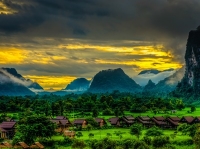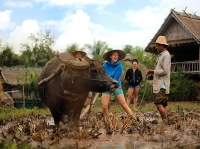Weather Summary
Despite having two distinct weather seasons you can travel in Laos all-year-round and with no coastline to influence things, Laos’s weather system is relatively straight-forward compared with much of Asia; consisting of a dry season (October to late April) and a wet season (May to late September). Within each season there are variations in temperature, with the dry months leading up to the wet season (March and April) and the early wet season (May and June) usually being the hottest of the year.
Temperatures throughout the country are also greatly affected by altitude with much of the country at an level that reduces the country’s average temperatures by several degrees °C. As a general rule north, central and eastern regions are at a higher altitude than those in the south, where at its lowest, in the Mekong River valley, humidity is higher and temperatures in excess of 35°C are not uncommon between March and April.
The early months of the wet season (May – July) remain very hot and rainfall is often short lived, whilst in the latter months (late July – September) the rains tend to get more constant and can be heavy at times, especially in southern parts of the country. Further north and in Luang Prabang, rainfall tends to be lighter and you can often expect rain during the night or mornings with some relatively clear afternoons. Across Laos, throughout much of the rainy season, daytime temperatures average around 29°C in the lowlands and 23°C in the mountain valleys.
Throughout the country in all but the hottest months of the year it is often advisable to have a jumper or fleece for the evenings, when there is a tendency for it to get quite cool.
Luang Prabang
fleece for the evenings, when there is a tendency for it to get quite cool.
Luang Prabang
Luang Prabang, surrounded by jungle and ‘cut through’ by the flow of the great Mekong River, has a typical tropical-monsoon climate. The dry season is split into two halves, with the latter months being the hottest. During its ‘coldest’ months (December and January), temperatures can settle at around 17°C and nights and early mornings can be chilly. Once you reach March temperatures start to rise and come April and May it can peak as high as 33°C+.
During the wet season (May to October) you can expect heavy downpours for short periods, most commonly during the night or early morning. Initially this rarely lasts more than an hour or two, and helps to clear the air, leaving bright blue skies in its wake. Come August and September the rainfall can be more prolonged.
The Mekong River
February & March
In recent years water levels on certain stretches of the Mekong River have reached record lows duering February and March. This is not simply due to lower rainfall and global warming, but because of 8 new Chinese ‘super-dams’ stemming the water flow to ensure a plentiful water supply to regions of China outside of the Mekong River’s natural basin. The result of this damming is that the rivers fish stocks are declining dramatically in the lower Mekong countries, with other wildlife expected to become quickly over-hunted as a result.
At this time a typically disappointing amount of international pressure is being applied to China to exercise more stringent control on their damning procedure to ensure the countries of the lower Mekong receive acceptable levels of water.







